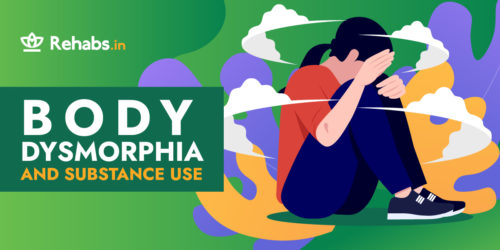Body Dysmorphia and Substance Use

If you had three wishes, would you use one — or all of them — to change your physical appearance? If you would, chances are you are not alone.
A study published in the Body Image journal and reported by the online edition of Time Magazine reveals that men and women are equally unhappy about their appearance. And if we were to go by nationality, the Japanese top that list, with 38% saying they are “not too satisfied” or “not at all satisfied” with their appearance, followed by around 20% of British, Russians, and South Koreans. This data is from a market research group GfK survey with over 27,000 respondents, aged 15 or over, in 22 countries.
Additionally, the growing number of people resorting to surgically changing their physical appearance is evident from the expected increase in the value of the global cosmetic surgery industry to USD201.0 billion by 2031 from USD67.3 billion in 2021, according to a report by Allied Market Research. Cosmetic surgery, unlike reconstructive surgery, may not be considered medically necessary.
Furthermore, the unrealistic beauty standards set by social media filters also contribute to growing unhappiness in body image. And it won’t be surprising if “why am I so ugly?” is a question that most people may — now more than ever — ask about themselves.
This issue, however, could be a lot worse if you were to feel a constant, debilitating sense of doom and dread about your appearance — even resorting to coping with it through substance abuse.
If so, you could be experiencing a condition called Body dysmorphia or Body dysmorphic disorder (BDD). A report in the US National Library of Medicine reveals that people with BDD have a greater risk of developing substance addiction. Researchers found that nearly 70% suffering from substance addiction believe that body dysmorphia was a reason for their dependency.
However, before we delve further into the correlation between BDD and substance abuse, let us first look at BDD, its symptoms, and its causes.
What is Body dysmorphia or BDD?
The National Health Service (NHS), UK, describes BDD as a mental health condition where a person spends a lot of time worrying about flaws in their physical appearance. These flaws are usually unnoticeable to others.
So, what is body dysmorphia like? According to a Dialogues in Clinical Neuroscience study, BDD finds its first mention by Italian physician Enrique Morselli in 1891, calling it dysmorphophobia — the fear of having a deformity. To explain the lived experience of the disorder, Morselli wrote: the dysmorphophobic patient is miserable; in the middle of his daily routines, conversations, while reading, during meals, in fact everywhere and at any time, is overcome by the fear of deformity, which may reach a painful intensity, even to the point of weeping and desperation.
In 1987, the American Psychiatric Association classified BDD as a distinct somatoform disorder.
The 11th revision of the International Classification of Diseases of the World Health Organization (WHO), ICD-11, defines the symptoms of BDD as below:
- Persistent preoccupation with one or more perceived defects or flaws in appearance, or ugliness in general, that is either unnoticeable or only slightly noticeable to others.
- Excessive self-consciousness about the perceived defect(s) or flaw(s) often includes ideas of self-reference [i.e., the conviction that people are taking notice, judging, or talking about the perceived defect(s) or flaw(s)].
- The preoccupation, or self-consciousness, is accompanied by any of the following:
- Repetitive and excessive behaviours, such as repeated examination of the appearance or severity of the perceived defect(s) or flaw(s) (e.g., by checking in reflective surfaces) or comparison of the relevant feature with that of others;
- Excessive attempts to camouflage or alter the perceived defect (e.g., specific and elaborate forms of dress, undergoing ill-advised cosmetic surgical procedures);
- Marked avoidance of social or other situations or stimuli that increase distress about the perceived defect(s) or flaw(s). (e.g., reflective surfaces, changing rooms, swimming pools).
Experts at John Hopkins Medicine, a leading medical research and education organisation, reveal that “a person with BDD may be so upset about their appearance that it gets in the way of their ability to live normally.” They explain that “while many of us may think we have flaws in our appearance, our response to this flaw could be overwhelming with BDD. You may find that negative thoughts about your appearance are hard to control. You may even spend hours each day worrying about how you look. The thinking can become so negative that people with BDD may even feel suicidal”.
What causes Body Dysmorphia?
While the exact cause of Body Dysmorphia or BDD is still largely unknown, research suggests that the condition could involve issues with the functioning or size of some parts of the brain that process information about physical appearance. Moreover, studies show that BDD often occurs in people with other mental health disorders, such as advanced depression and anxiety. Furthermore, experts believe that factors that can also trigger or influence the development of BDD include experiencing criticism about their appearance from family members, traumatic events or emotional conflict during childhood, and low self-esteem. And that pressure from peers and a society that measures beauty and value with physical appearance can also contribute to the development of BDD.
What is the relationship between BDD and substance abuse?
People with BDD often have a dual diagnosis, which means that in addition to the mental health condition, they also have a substance use disorder. According to a report in the official journal of the World Psychiatric Association (WPA), around 50% of individuals with severe mental disorders are affected by substance abuse. Many turn to illicit substances to cope with the symptoms of mental health illness. A person with such co-occurring disorders may experience symptoms of both a mental health issue and a substance addiction. What complicates the situation further is that the co-occurring conditions could also adversely affect each other. So, when a mental health illness is untreated, it can worsen the substance abuse problem and vice versa.
For a person with BDD, illicit substances such as alcohol and drugs can feel like they provide relief from distressing thoughts. However, this relief is only temporary and usually worsens the obsessive thoughts and symptoms of depression and anxiety more than before. Due to this see-saw effect, people with BDD are more likely to act on distorted thinking while under the influence of a substance. Moreover, the social stigma of substance addiction often causes people with this challenge to feel deeply flawed. It can worsen any tendency toward shame related to the and cause symptoms of body dysmorphia to develop.
How can you treat a person experiencing both BDD and substance addiction?
When treating a mental health condition such as BDD, it is critical to recognise any comorbidity — the simultaneous presence of two or more medical conditions or diseases — such as substance use disorder. That is because identifying and treating the substance use disorder could significantly help treat the mental health condition.
Although research on effective treatment is still limited, a report by BDD expert Dr Katherine Philips in the World Psychiatry journal recommends serotonin reuptake inhibitors (SRIs), a class of antidepressant medications, as the medication treatment of choice for people with BDD. The treatment involves a relatively high SRI dose over at least 12 weeks with cognitive behavioural therapy (CBT), a common type of planned, goal-oriented talk therapy, as the psychosocial treatment.
A clinical trial report in the Psychiatric Clinics of North America journal suggests that individuals with BDD can benefit from group CBT therapy. As part of the trial, participants with BDD met in small groups for 90 minutes each over 12 weekly CBT sessions. Throughout treatment, the participants found significant alleviation of both BDD and depression symptoms. CBT group therapy helps mainly because of the positive effects of peer support and social learning. The sessions help people with BDD learn to know they are not alone. Moreover, the empathy and support from treatment groups offer communities for healing and sustained recovery.
References
Frederick, David A; Sandhu, Gaganjyoti; Morse; Patrick J; Swami, Viren (June 2016), Correlates of appearance and weight satisfaction in a U.S. National Sample: Personality, attachment style, television viewing, self-esteem, and life satisfaction Body Image Journal – Volume 17 (Pages 191-203) Science Direct https://www.sciencedirect.com/science/article/abs/pii/S1740144516301498
Growth from knowledge https://www.gfk.com/press/11-of-canadians-completely-satisfied-with-their-looks-gfk-study
D, Linu; S, Tanjeem; S, Onkar (May 2022) Cosmetic Surgery Market By Gender (Female, Male), By Age Group (13 to 29, 30 to 54, 55 and above), By Procedure (Breast augmentation, Eyelid surgery, Liposuction, Rhinoplasty, Others), By End User (Ambulatory surgical facility, Hospital and clinic, Office and cosmetic surgical center): Global Opportunity Analysis and Industry Forecast, 2021-2031 Allied Market Research https://www.alliedmarketresearch.com/cosmetic-surgery-market-A16492
Grant, Jon E., J.D., M.D.; Menard, William, B.A.; Pagano, Maria E., Ph.D.; Fay, Christina, B.A.; Phillips, Katharine A., M.D. (March 2005) Substance Use Disorders in Individuals With Body Dysmorphic Disorder J Clin Psychiatry National Library of Medicine https://www.ncbi.nlm.nih.gov/pmc/articles/PMC2504687/
NHS https://www.nhs.uk/mental-health/conditions/body-dysmorphia/
Bjornsson, Andri S., PhD; R. Didie, Elizabeth, PhD; Phillips, Katharine A. (June 2010) MD Body Dsymorphic Disorder Dialogues in Neuroscience Taylor & Francis Group US National Library of Medicine https://www.ncbi.nlm.nih.gov/pmc/articles/PMC3181960/
World Health Organization – International Classification of Diseases 11th Revision https://icd.who.int/browse11/l-m/en#/http://id.who.int/icd/entity/731724655
John Hopkins Medicine https://www.hopkinsmedicine.org/health/conditions-and-diseases/body-dysmorphic-disorder
Hunt, Thomas J., MD; Thienhaus, Ole, MD, MBA; Ellwood, Amy, MSW, LCSW (2008) The Mirror Lies: Body Dysmorphic Disorder American Family Physician https://www.aafp.org/pubs/afp/issues/2008/0715/p217.html
Phillips, Katharine (Feb 2004) A Body dysmorphic disorder: recognizing and treating imagined ugliness World Psychiatry Official Journal of the World Psychiatric Association (WPA) US National Library of Medicine https://www.ncbi.nlm.nih.gov/pmc/articles/PMC1414653/
WebMD https://www.webmd.com/mental-health/mental-health-body-dysmorphic-disorder
Drake, Robert E; Mueser T Kim; Brunette, Mary F (Oct 2007) Management of persons with co-occurring severe mental illness and substance use disorder: program implications World Psychiatry Official Journal of the World Psychiatric Association (WPA) US National Library of Medicine https://www.ncbi.nlm.nih.gov/pmc/articles/PMC2174596/
McHugh, Kathryn R.; Hearon, Bridget A.; Otto, Michael W, PhD Cognitive Behavioral Therapy for Substance Use Disorders Science Direct https://www.sciencedirect.com/science/article/abs/pii/S0193953X10000547?via%3Dihub













